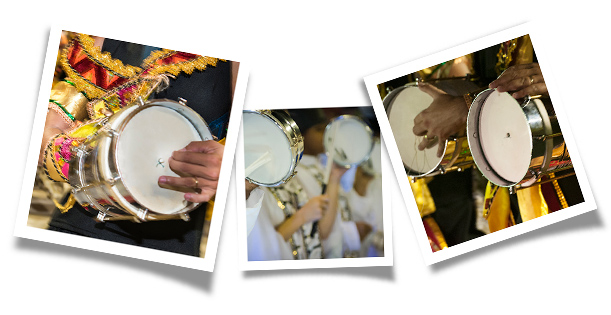The result was samba! Know the history of the musical style that symbolizes Brazilian culture!
From being rejected by the upper class to becoming the pride of the nation, samba’s path is intertwined with Brazilian history and Carnival roots. Here is some information to learn a bit about this journey.
1 – Enter in the circle! The Circular Samba (Samba-de-Roda) is the origin of the style in Brazil. It started in 1860, with African slaves in Bahia that mixed their musical traditions. It soon arrived in Rio de Janeiro and today is considered a part of world heritage by UNESCO, a truly remarkable achievement!
2 – But it wasn’t all roses. Samba used to be forbidden! The musical style was looked upon poorly by the Brazilian elite and was even considered a criminal activity in the 1920s. If someone was caught playing samba or dancing in the streets, they could end up in jail.
3 – And hope defeated fear! In the beginning of the 40’s, with Getúlio Vargas as the Brazilian president, samba starts to be considered a national symbol and is deservingly appreciated as the artistic expression that it’s always been. It was about time!
4 – And what about the first hit? The first samba to be recorded is called Pelo Telefone (On the Telephone). The recording happened in 1916 and it was a huge success in the following years’ Carnival. The lyrics really say it all about the Carnival vibe: “Leave your sorrows behind!â€
5 – You thought that we wouldn’t talk about the parades? Think twice! The samba themes that guide the samba schools performances started in 1930. In the beginning, there were two different and improvised sambas, one played one way down the parade avenue and the other on the way back. There have been lots of changes since then, but the joy of those who watch and participate in Carnival remains overwhelming and is contagious!
6 – That was just a bit of the immense samba history. As we all know, today the rhythm is sacred. It’s part of Rio’s entertainment and culture, with classic circle sambas spread throughout the city. The Rua do Ouvidor and Pedra do Sal sambas are two excellent choices for witnessing this traditional performance.
7 – Want to know more? The Rio Art Museum (MAR) is holding an exhibition with more than 800 items related to samba, from paintings to historical objects. It’s a great cultural outing to get in the Carnival mood! The greatest show on Earth is just around the corner!


COMENTÁRIOS